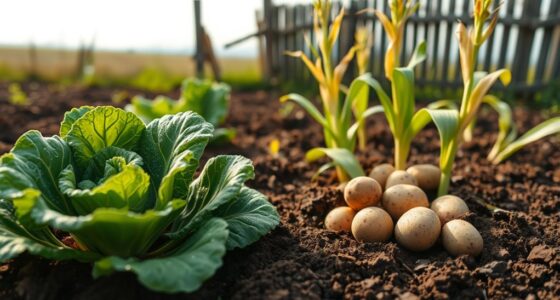To maximize your potato yields, focus on soil health by maintaining a slightly acidic pH and increasing organic matter. Use balanced fertilizers, paying attention to potassium and phosphorus for better growth. Implement drip irrigation to enhance water efficiency and avoid drought stress. Crop rotation with legumes can improve soil and pest management. Finally, choose disease-resistant varieties to reduce risks. There's more to discover about effective techniques that can boost your harvest even further.
Key Takeaways
- Test soil pH and improve it to a slightly acidic range of 5.0 to 6.5 for optimal potato growth.
- Incorporate organic matter like well-rotted manure to enhance soil structure and water retention.
- Implement a balanced fertilization strategy focusing on potassium and phosphorus to boost yields by 15–30%.
- Practice crop rotation with legumes or brassicas to disrupt pest cycles and improve soil health.
- Utilize consistent watering practices and monitor soil moisture to prevent drought stress during critical growth periods.
Understanding Soil Health and Preparation
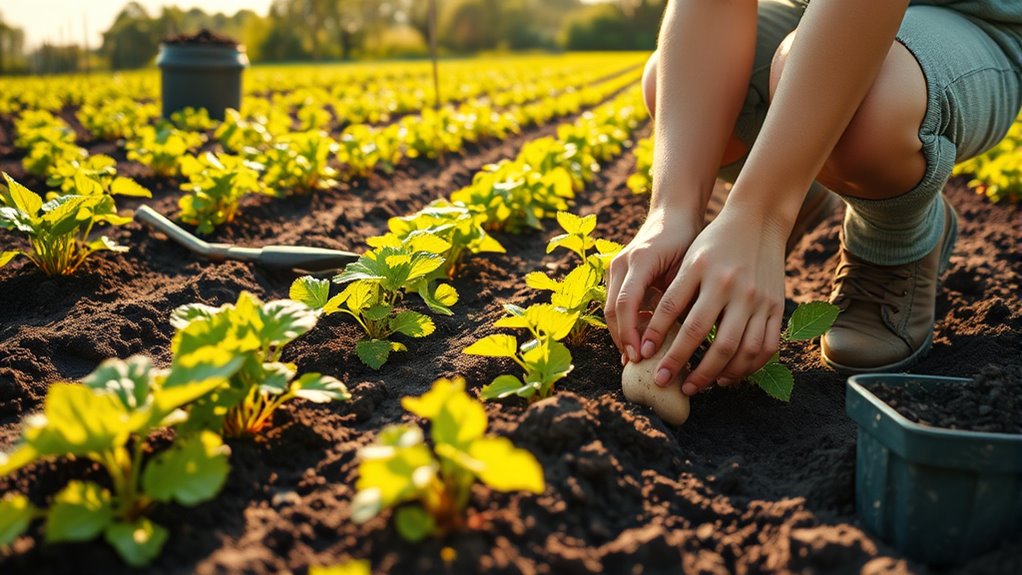
To guarantee your potato yields reach their full potential, understanding soil health and preparation is vital. Start by testing your soil to confirm it's slightly acidic, ideally between 5.0 and 6.5 pH, since potatoes prefer this range for ideal growth.
Increasing organic matter is essential; even a 1% boost can greatly enhance water retention, helping during dry spells. Incorporate well-rotted manure or compost to improve soil structure and confirm good drainage. This preparation not only supports healthier potatoes but also enhances crop performance.
Additionally, consider crop rotation with cereals, legumes, or brassicas to enrich soil nutrients and disrupt pests, which can increase your potato yields by 15–20%. Prioritize these steps to maximize your harvest.
Effective Fertilization Strategies
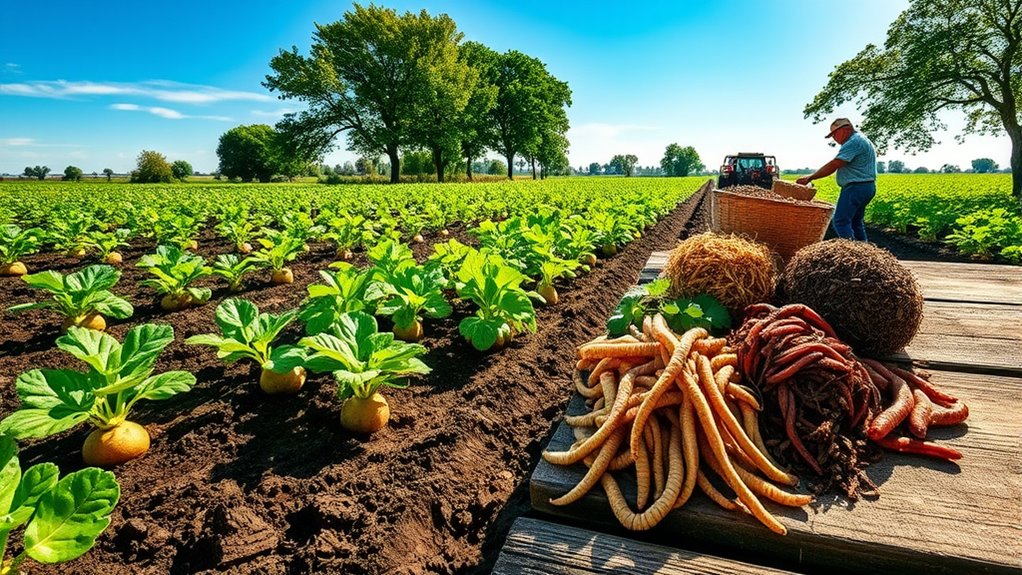
To maximize your potato yields, focus on balanced nutrient application and enhance your soil with organic matter.
Incorporating farmyard manure can boost fertility while maintaining moisture levels.
Balanced Nutrient Application
When aiming to maximize potato yields, balanced nutrient application plays an essential role in achieving ideal results. A balanced fertilizer application can boost your yields by 15–30%, especially by incorporating potassium and phosphorus for better starch production and root development.
Start with soil testing to assess nutrient levels and pH, aiming for a range of 5.0–6.5, to tailor your fertilization strategy effectively. Gradual fertilizer application helps maintain prime nutrient availability throughout the growing season, particularly during critical bulking phases.
Be cautious with nitrogen; excessive amounts can hinder tuber development and reduce yields by up to 25%. By focusing on a balanced approach, you'll support healthy growth and improve your potato yields considerably.
Organic Matter Enhancement
Balanced nutrient application paves the way for exploring organic matter enhancement, an essential strategy for boosting potato yields. Incorporating well-rotted manure or compost into your soil considerably improves soil structure and drainage, which can elevate your potato yields by 10–20%.
By increasing organic matter by just 1%, you can enhance water retention capabilities, providing an extra 20,000 gallons of water per acre—crucial during dry spells.
Additionally, gradually applying balanced fertilizers rich in potassium and phosphorus will support starch production and root development, potentially increasing yields by 15–30%.
Optimal Watering Techniques

Effective watering techniques are vital for maximizing potato yields. Potatoes need about 500–700 mm of water during their growing season, especially when tubers are bulking.
To maintain consistent moisture, consider implementing drip irrigation. This method can enhance water efficiency by 25–50%, ensuring your potatoes get the right amount of moisture without the risk of overwatering.
Regularly monitor soil moisture levels with tools to maintain ideal watering practices. This not only helps prevent drought stress but also reduces the risk of diseases like blackleg caused by excess water.
Make sure to prioritize watering during dry spells, as your potatoes thrive on regular moisture, particularly in the critical weeks leading up to harvest.
Employing Crop Rotation
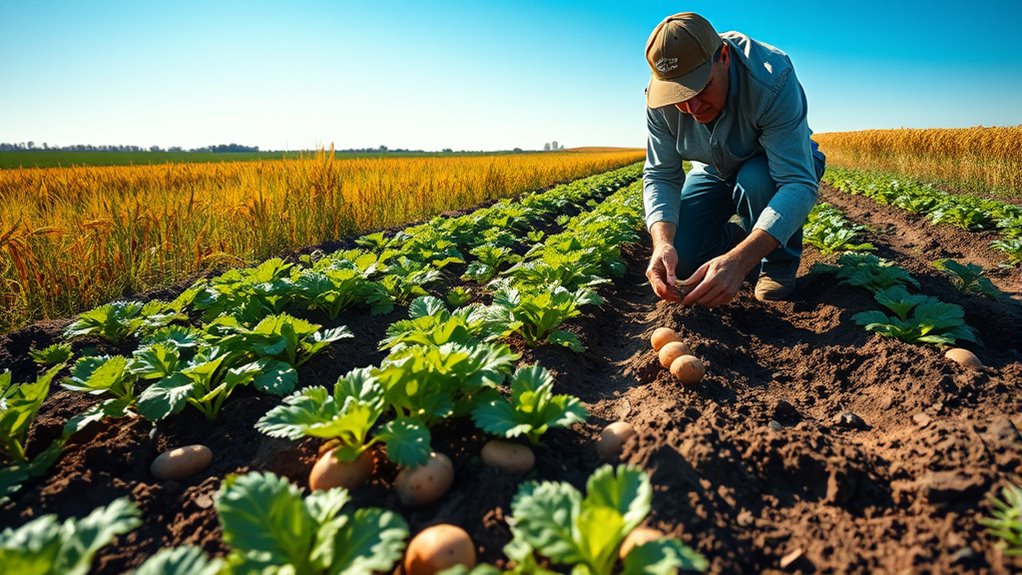
Employing crop rotation can markedly boost your potato yields and improve soil health.
By selecting the right combinations of crops and timing your rotations effectively, you can enhance nutrient availability and reduce pest risks.
Let's explore the benefits, suitable pairings, and how often you should rotate your crops for the best results.
Benefits of Crop Rotation
When you rotate crops like cereals, legumes, or brassicas with potatoes, you can greatly boost your yields by 15-20%. This practice enhances soil health and nutrient availability, making your potato crops thrive.
Here are some key benefits of crop rotation:
- Disrupts pest and disease cycles: Rotating with non-related crops reduces the risk of infestations and infections, leading to healthier plants.
- Improves soil nitrogen levels: Incorporating legumes enriches the soil, which translates to better growth for future potato crops.
- Enhances soil structure: Following potatoes with deep-rooted crops breaks up compacted soil, improving aeration and drainage.
Suitable Crop Combinations
Choosing the right crop combinations for rotation can greatly impact your potato yields. By incorporating legumes like peas and beans, you can enhance soil fertility, boosting potato yields by 15-20%. Cereal crops such as wheat or barley help reduce pests and diseases that threaten potatoes, promoting healthier growth. Brassicas, like cabbage or broccoli, suppress nematodes and soil-borne pathogens. Cover crops, including clover or vetch, increase organic matter, enhancing water retention and nutrient availability. Implementing a three to four-year rotation cycle specifically designed for potatoes can considerably mitigate the buildup of pests and diseases.
| Crop Type | Benefits | Timing |
|---|---|---|
| Legumes | Improve soil fertility | Year 1 |
| Cereals | Reduce pests and diseases | Year 2 |
| Brassicas | Suppress soil-borne pathogens | Year 3 |
| Potatoes | Main crop | Year 4 |
| Cover Crop | Enhance organic matter | Year 5 |
Timing and Frequency
To maximize your potato yields, timing and frequency in crop rotation play a crucial role.
By alternating potatoes with cereal crops or legumes, you can enhance soil health and boost yields by 15-20%.
Here's how to implement effective crop rotation:
- Rotate every 2-3 years: This practice prevents soil-borne diseases and promotes the health of subsequent potato varieties.
- Plant after legumes: Legumes enrich nitrogen levels, supporting robust potato growth for higher yields.
- Change planting locations: Moving potatoes to different soil zones each year maintains soil health and fertility over time.
Selecting Disease-Resistant Varieties

Selecting disease-resistant potato varieties is essential for enhancing your crop's yield and quality, especially in the face of threats like late blight. By choosing varieties such as Rooster and Maris Piper, you can reduce the risk of late blight by 30–50%, leading to higher yields.
It's also wise to consult local agronomists who can guide you in selecting the best-performing varieties suited to your specific climate and soil type. For processing, consider Golden Wonder, which has a higher dry matter content, making it more marketable.
Regular discussions with fellow farmers and agronomists can help you stay informed about disease-resistant options, maximizing your overall productivity and market competitiveness.
Utilizing Hilling and Mulching Methods

As your potato plants reach about 8 inches tall, hilling becomes an essential practice that can greatly boost your yields.
By covering the stems with soil, you promote tuber growth and prevent greening.
Here's how to effectively use hilling and mulching methods:
- Start hilling when plants reach 8 inches to enhance yields and suppress weeds.
- Apply biodegradable mulches, like grass clippings or weathered leaves, when plants are ankle-high to maintain soil moisture and temperature.
- Regularly layer mulch until plants begin to fail, ensuring the root zone stays cool and moist.
Combining hilling and mulching not only maximizes your potato yields but also creates ideal growing conditions for your potato plants.
Harvesting and Storage Best Practices
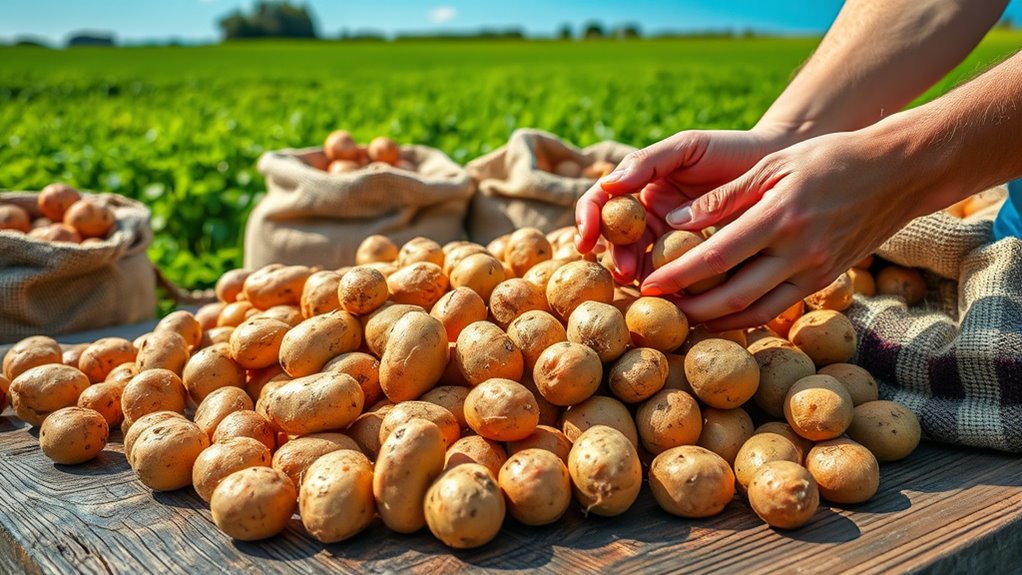
Harvesting your potatoes at the right time is essential for ensuring the best quality and yield. Wait until the plants have died back, then give it 2-3 weeks for ideal tuber maturity.
Choose a dry day for harvesting, as this prevents soil from sticking to the tubers and reduces damage. After harvesting, cure your potatoes in a dark, dry space with good airflow for two weeks to enhance their storage longevity and prevent rot.
For storage, keep cured potatoes in a cool (40-45°F), dark, and well-ventilated area. Check them monthly for spoilage, removing any affected tubers immediately.
Frequently Asked Questions
What Is the Best Way to Increase Potato Yield?
To increase your potato yield, start by hilling the plants as they grow; this promotes tuber development and prevents greening.
Make sure you space your seed potatoes 12-14 inches apart to avoid overcrowding, which can stifle growth.
Maintain ideal soil health by adding compost and well-rotted manure.
Don't forget to water regularly, especially during the bulking stage, and consider using resistant varieties to fend off diseases that can diminish your yield.
How to Make Potato Plants Produce More Potatoes?
Imagine a backyard gardener, Sarah, who doubled her potato yield by hilling her plants.
To make your potato plants produce more, start by mounding soil around them when they're about 8 inches tall. This not only encourages growth but also protects tubers from sunlight.
Additionally, make certain you space your seed potatoes 12-14 inches apart and maintain consistent soil moisture.
With these steps, you'll boost your harvest and enjoy a bountiful crop.
What Is the Best Booster for Potatoes?
When it comes to boosting your potato plants, bone meal's one of the best options. It's packed with phosphorus and calcium, which are essential for tuber development.
Additionally, mixing in well-rotted manure or compost improves soil structure and nutrient availability.
Don't forget to balance your fertilization, focusing on potassium and phosphorus, to promote healthy growth.
Testing your soil pH and using organic mulch can further enhance your potatoes' health and yield.
How Do I Get the Most Out of My Potato Plants?
To get the most out of your potato plants, start by spacing them 12-14 inches apart to prevent overcrowding.
Use the hilling method when plants reach 8 inches tall to boost yield and avoid greening.
Keep the soil consistently moist, especially if it's sandy, and choose a well-draining mix rich in organic matter.
Finally, monitor your watering to provide 500-700 mm during the growing season for ideal tuber development.
Conclusion
By combining simple techniques, you can transform your potato harvest from meager to bountiful. Picture the thrill of digging up plump, healthy potatoes, their rich earthy scent filling the air, versus the disappointment of a sparse yield. When you invest in soil health, water wisely, and choose the right varieties, you're not just growing food—you're cultivating success. Embrace these strategies, and you'll find joy in every harvest, turning the ordinary into the extraordinary.




